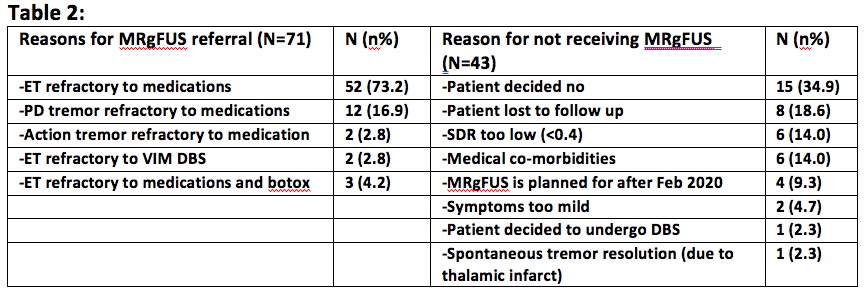Objective: To evaluate referrals, patient characteristics and decision outcomes for MRI guided focused ultrasound at a single neuromodulation center.
Background: Transcranial MRI guided focused ultrasound (MRgFUS) is an incisionless technique utilizing MR thermometry for thalamotomy, and is effective for unilateral treatment of tremor in essential tremor (ET) [1] and Parkinson’s disease (PD) [2]. Follow-up data has shown sustained benefit of tremor control in ET patients up to 5 years [3]. For patients who are poor candidates for deep brain stimulation (DBS), such as older age, cognitive impairment, or those who do not want hardware placement, MRgFUS is an effective option for symptomatic treatment of tremor.
Method: We performed a retrospective chart review of 71 referrals for MRI guided focused ultrasound over a 3 year time period, June 2017 – February 2020, to gather patient characteristics, including sex, diagnosis, mean skull density ratio, and decision outcomes, based on initial visit and follow up documentation.
Results: A total of 71 patients over a 3-year referral period were reviewed, of whom 28 underwent MRgFUS. Patient characteristics are detailed in [table 1]. Mean age of all referrals was 71.9. More male patients (69%) were referred than female patients. Most referred patients had a diagnosis of ET (80.3%). Mean skull density ratio (SDR) was 0.48 of all referrals. Reasons for referral and for not receiving MRgFUS are detailed in [table 2]. Most common reason for referral was ET refractory to medications in 52 patients. Reasons for not receiving MRgFUS included 15 patients who decided not to undergo the procedure, 8 lost to follow up, 6 with an SDR that was too low (<0.4), 6 with medical co-morbidity such as cardiac instability or newly diagnosed cancer, 2 with symptoms too mild for treatment, 1 who decided to undergo DBS, and 1 with spontaneous tremor resolution due to a thalamic infarct.
Conclusion: The majority of patients referred to our center for MRgFUS over a 3-year time period were male, over the age of 70 and diagnosed with essential tremor. The most common reason for referral was tremor refractory to medications. The most common reasons for not receiving MRgFUS were patients deciding not to undergo the procedure or lost to follow up, followed by low SDR or medical co-morbidities.
References: 1. Elias, W.J., et al., A Randomized Trial of Focused Ultrasound Thalamotomy for Essential Tremor. N Engl J Med, 2016. 375(8): p. 730-9. 2. Bond, A.E., et al., Safety and Efficacy of Focused Ultrasound Thalamotomy for Patients With Medication-Refractory, Tremor-Dominant Parkinson Disease: A Randomized Clinical Trial. JAMA Neurol, 2017. 74(12): p. 1412-1418. 3. Sinai, A., et al., Magnetic resonance-guided focused ultrasound thalamotomy for essential tremor: a 5-year single-center experience. J Neurosurg, 2019: p. 1-8.
To cite this abstract in AMA style:
L. Pan, M. Banvard, A. Mogilner, M. Pourfar. Retrospective review of MRI guided focused ultrasound thalamotomy referrals: experience from a single neuromodulation center [abstract]. Mov Disord. 2020; 35 (suppl 1). https://www.mdsabstracts.org/abstract/retrospective-review-of-mri-guided-focused-ultrasound-thalamotomy-referrals-experience-from-a-single-neuromodulation-center/. Accessed April 2, 2025.« Back to MDS Virtual Congress 2020
MDS Abstracts - https://www.mdsabstracts.org/abstract/retrospective-review-of-mri-guided-focused-ultrasound-thalamotomy-referrals-experience-from-a-single-neuromodulation-center/


